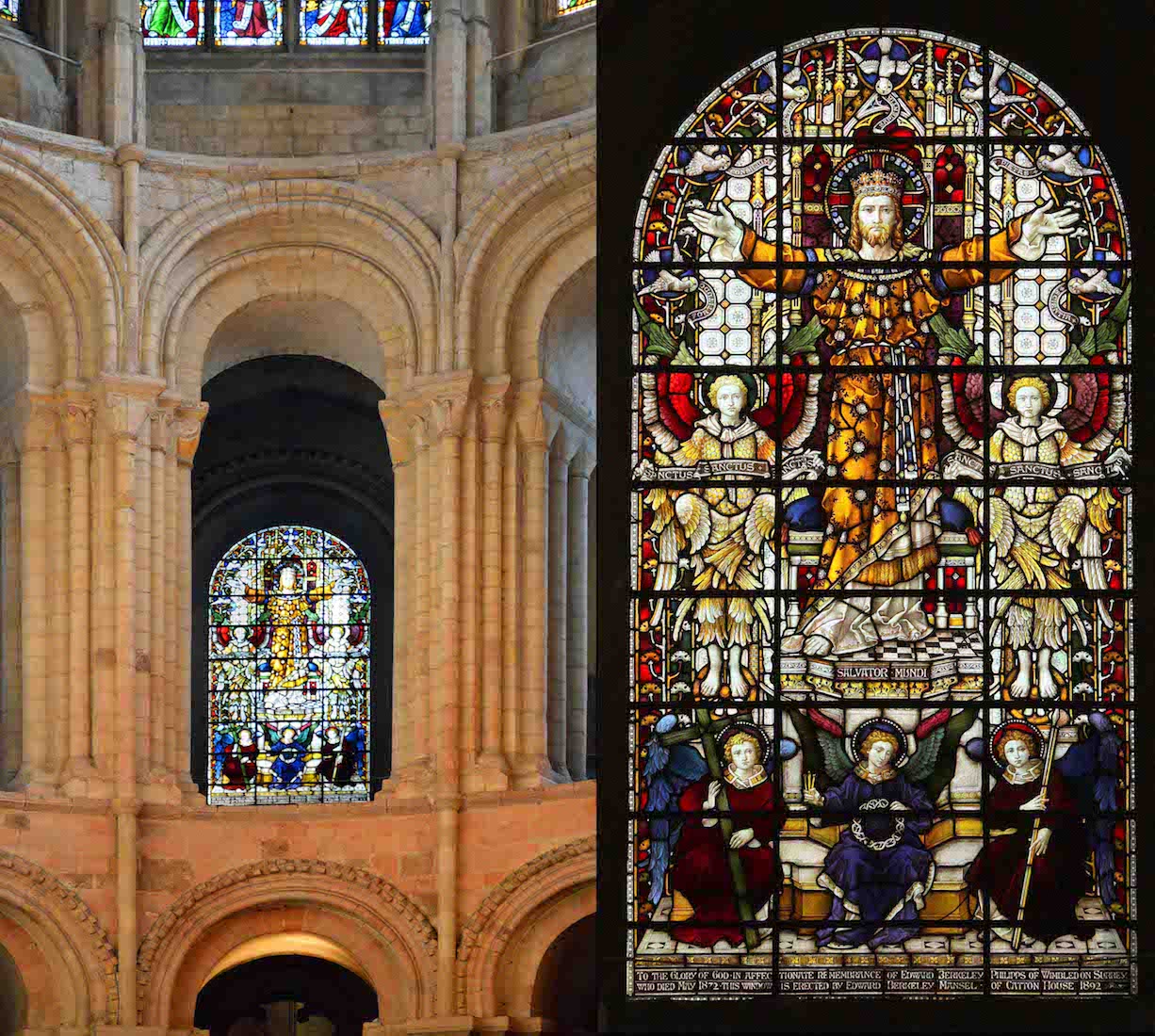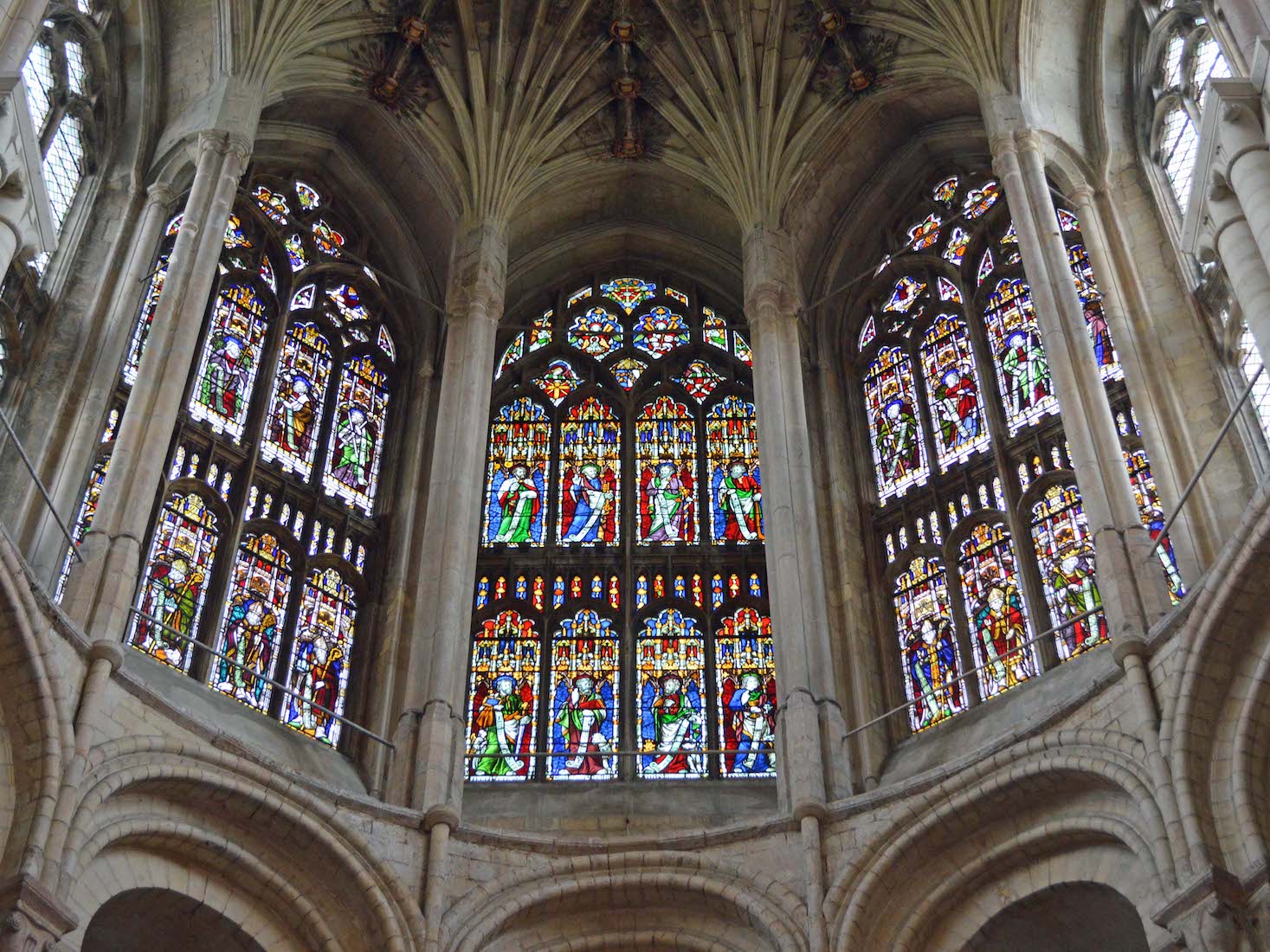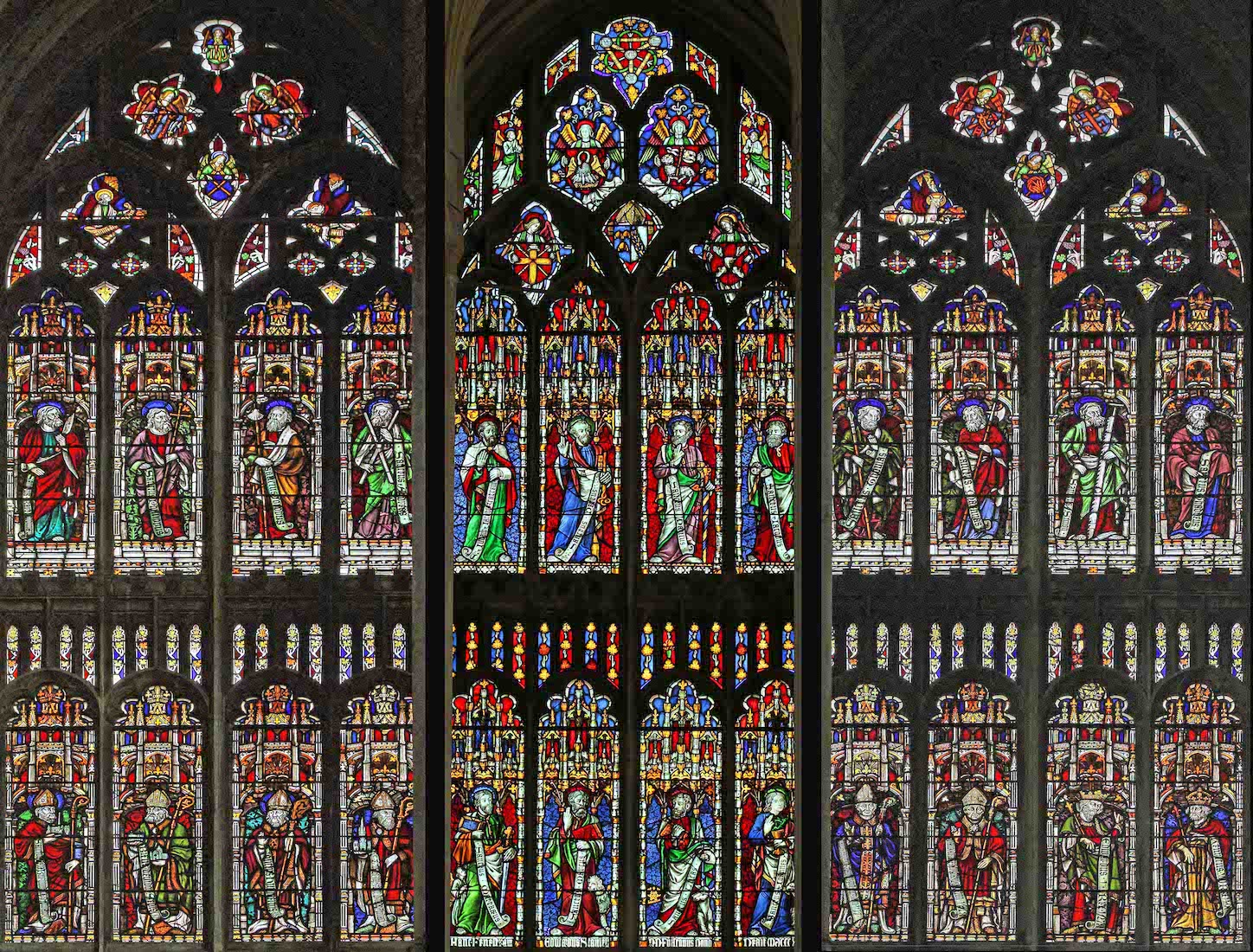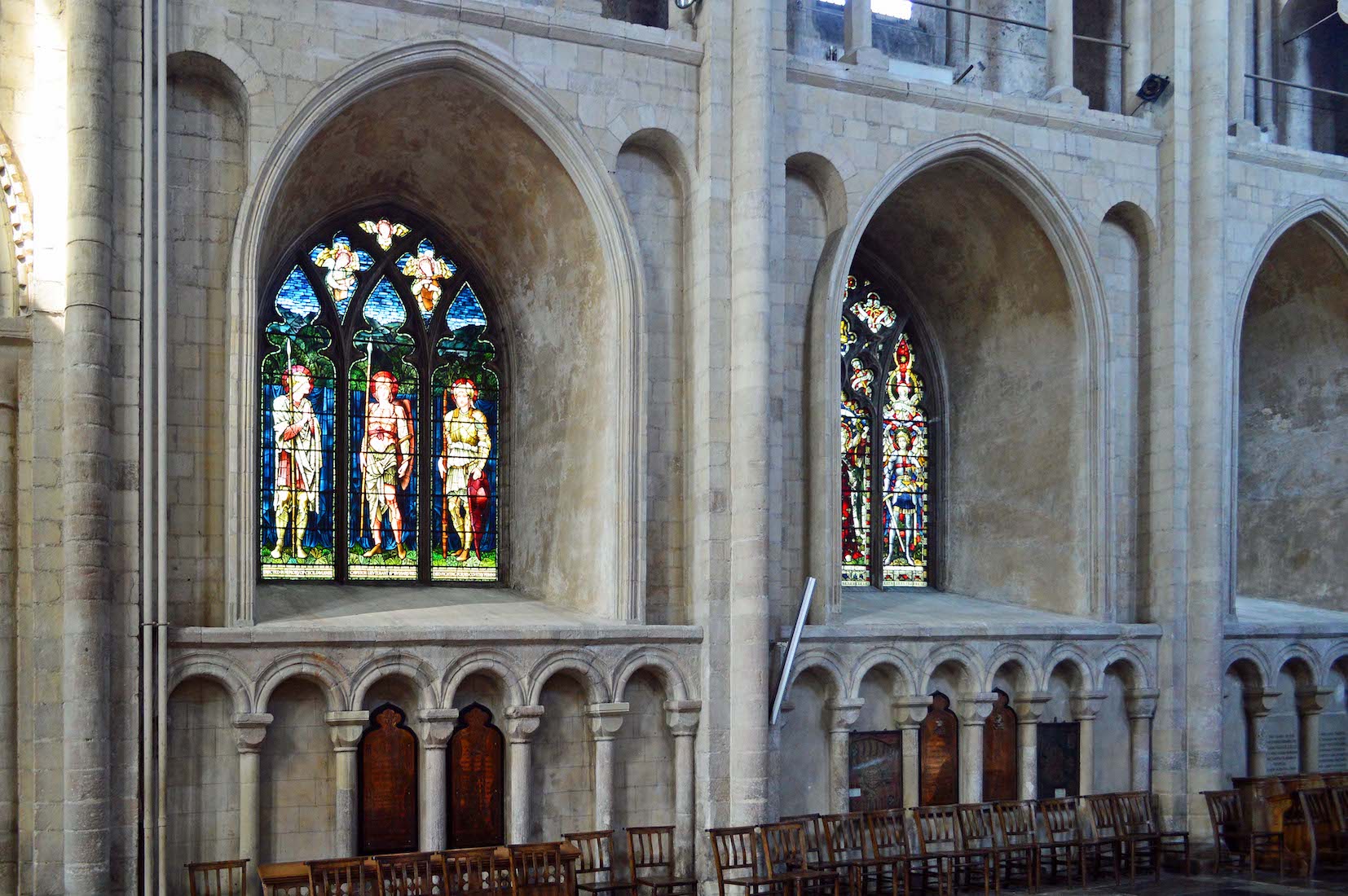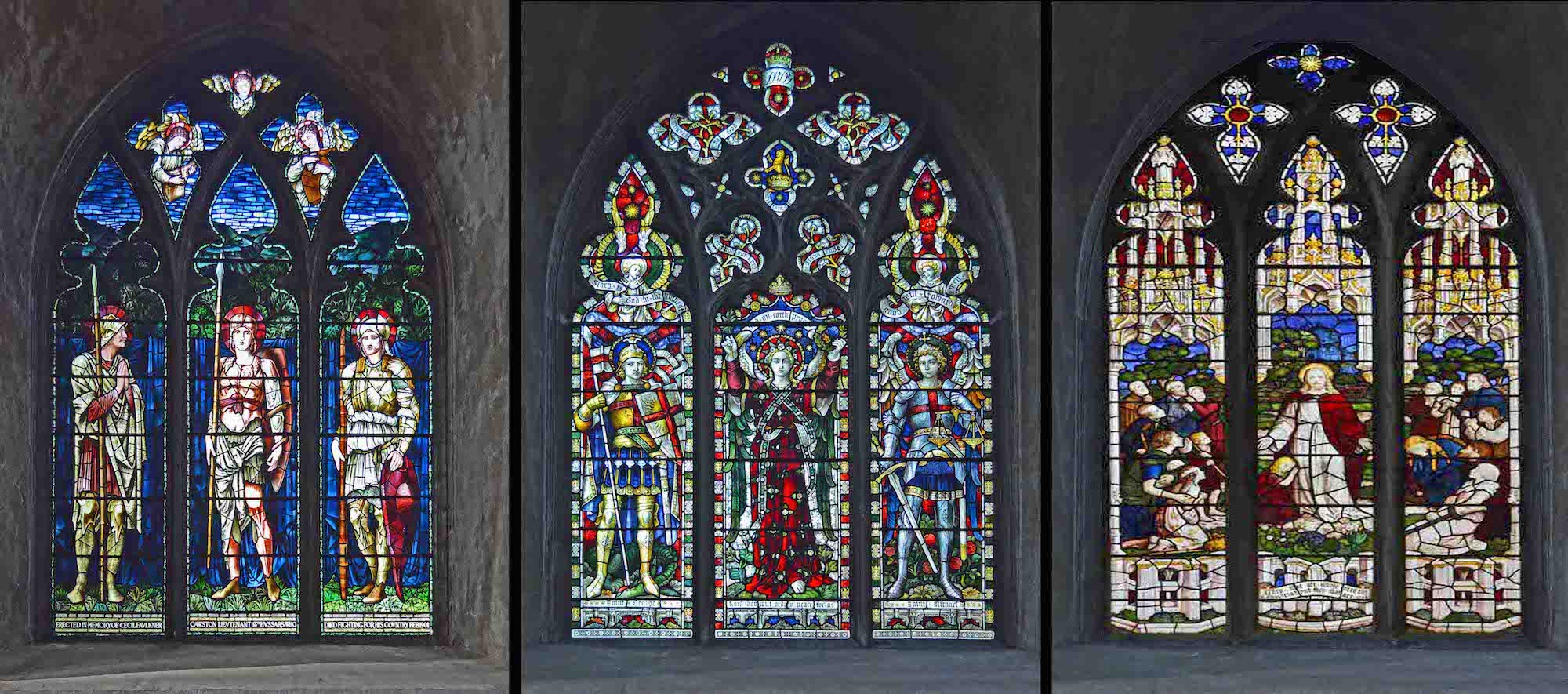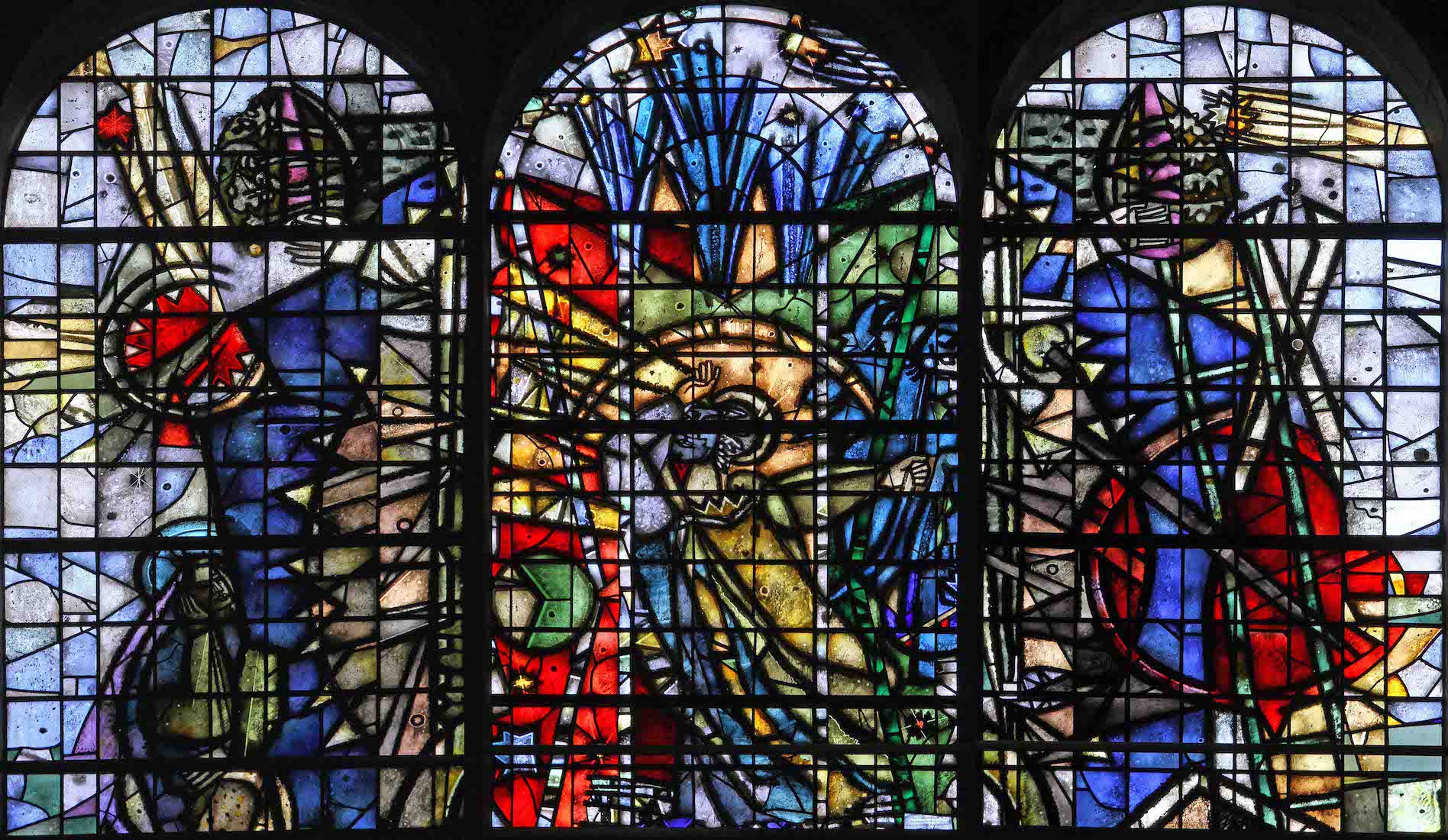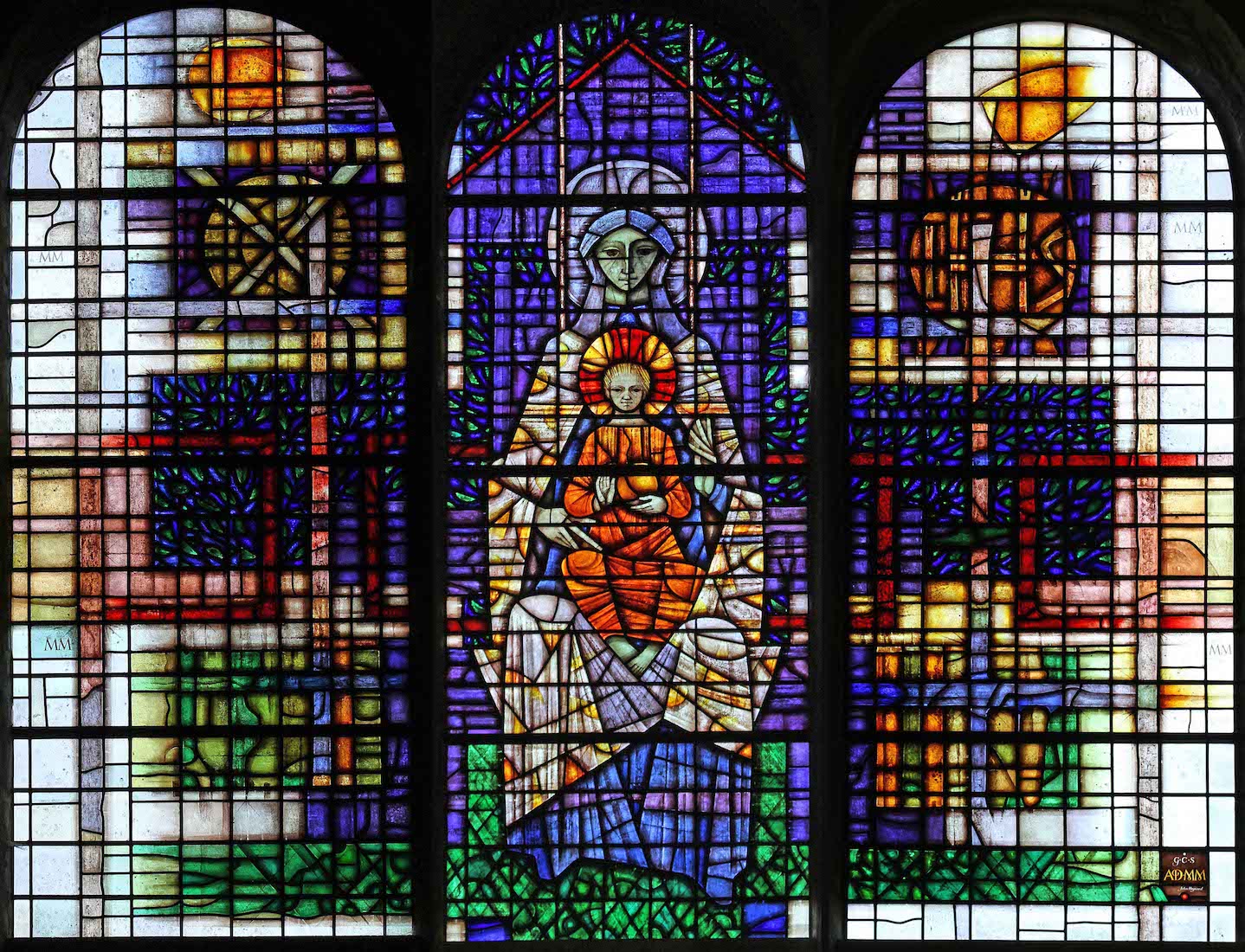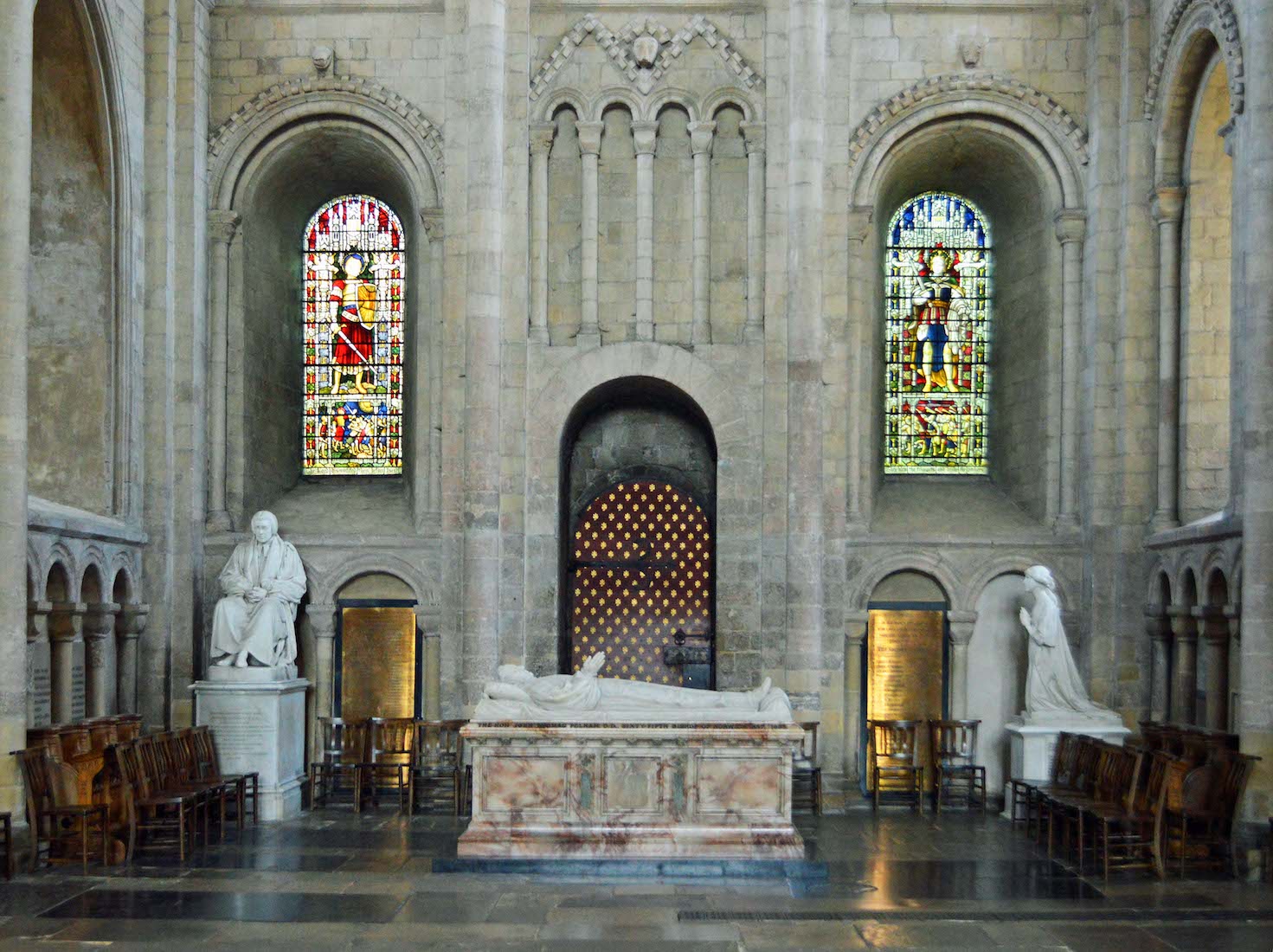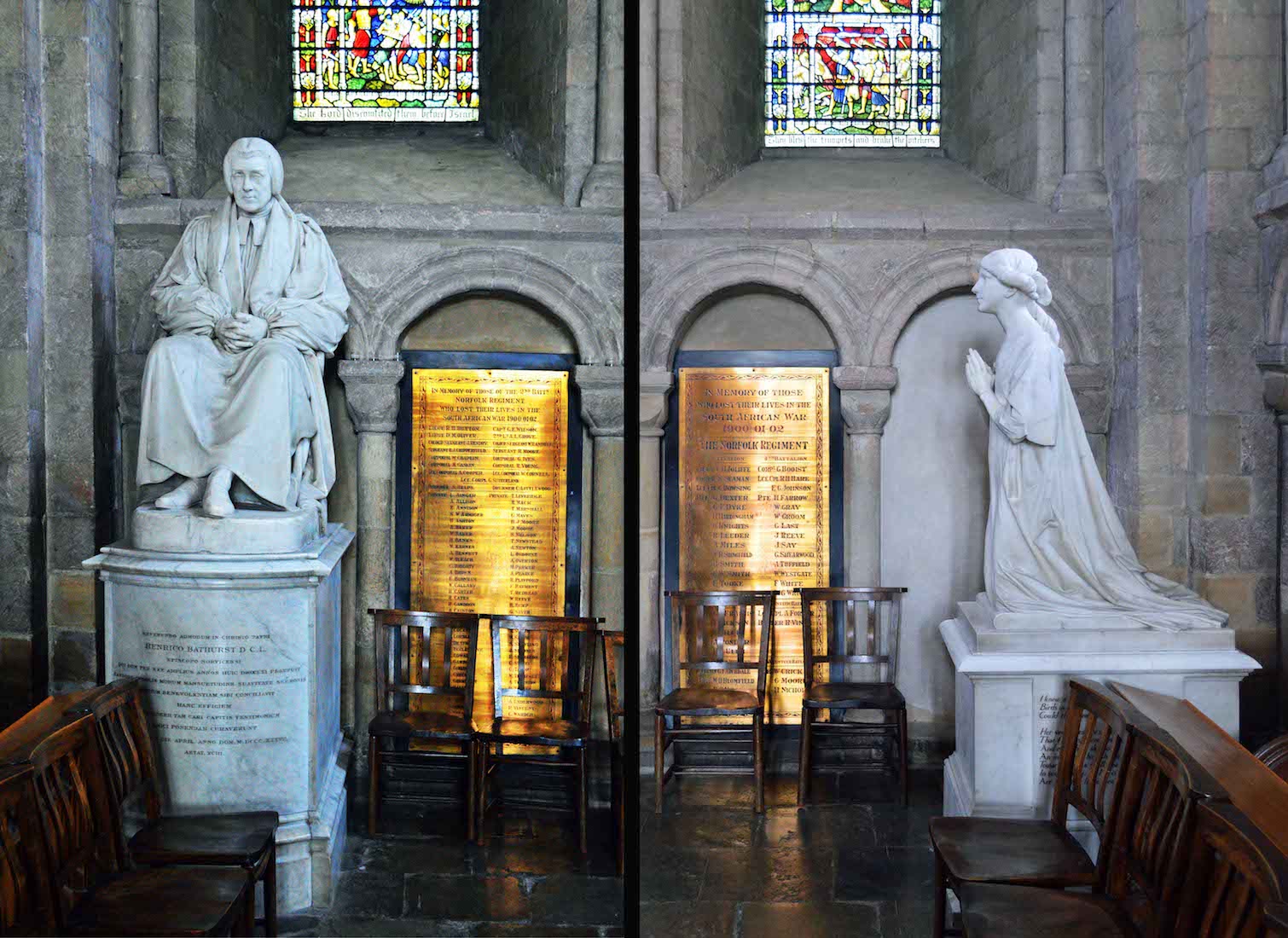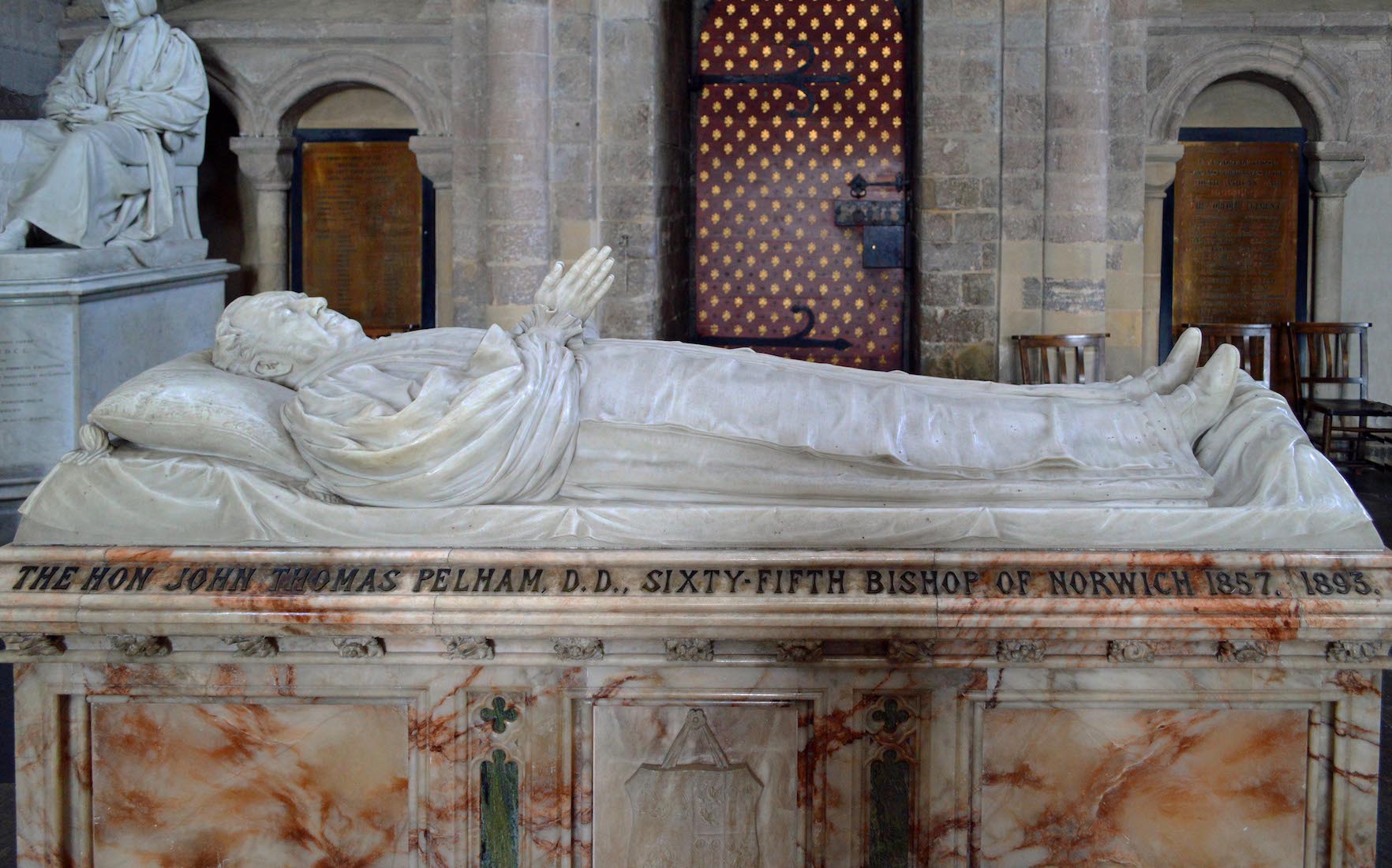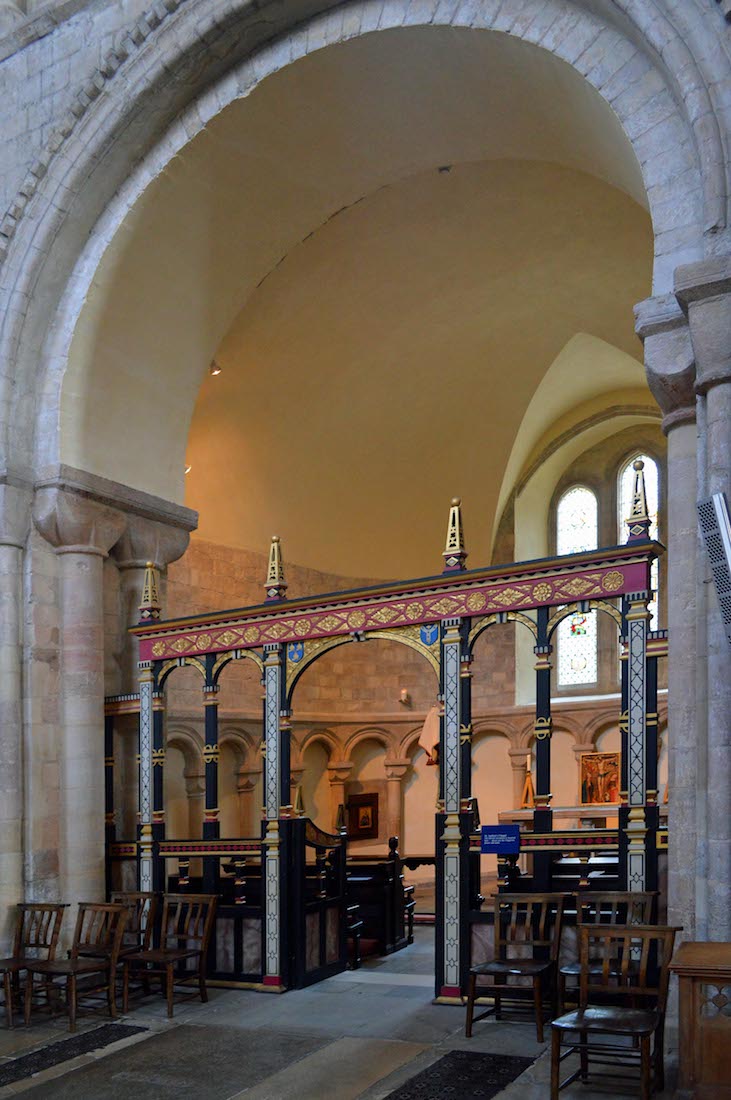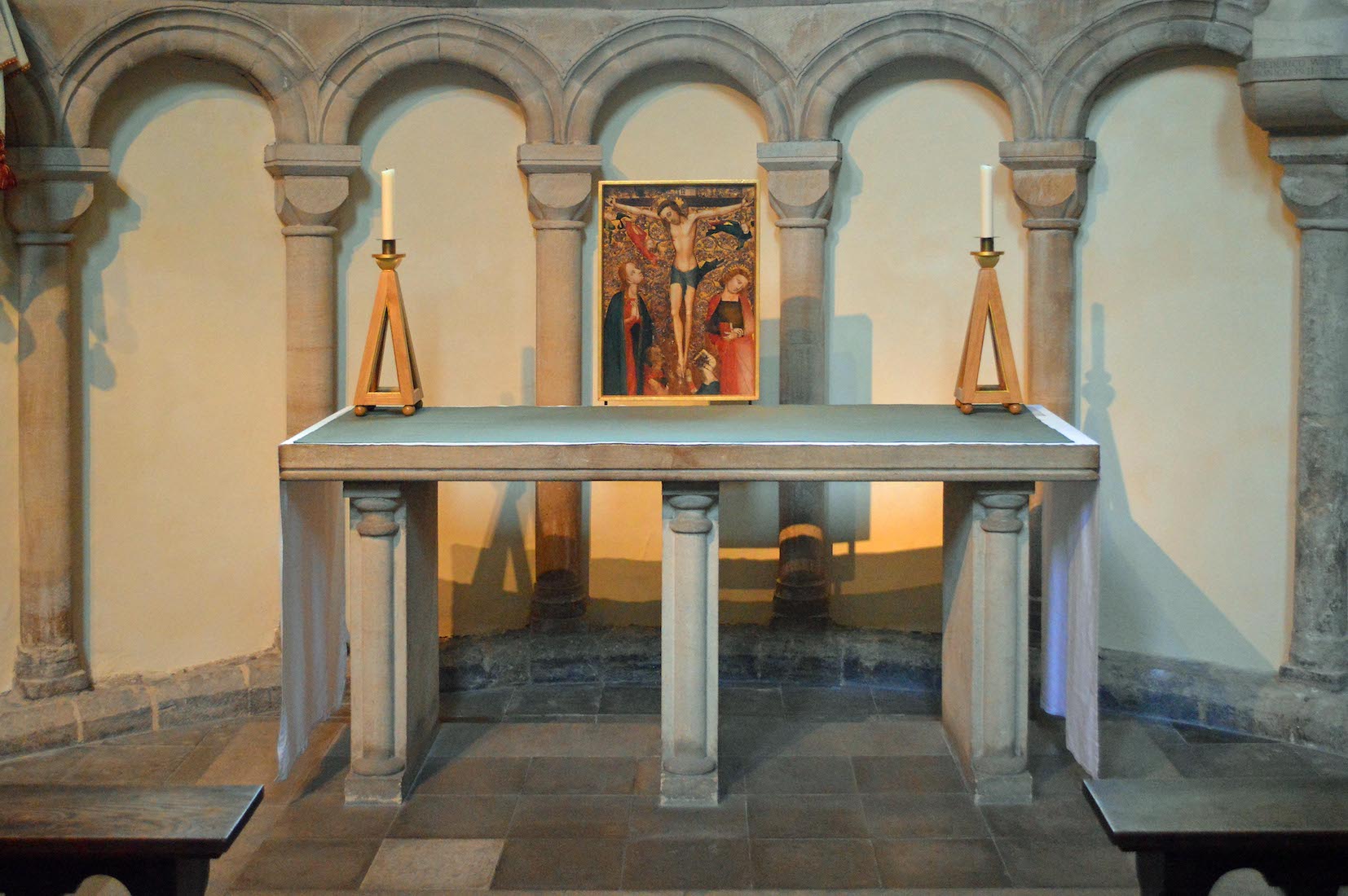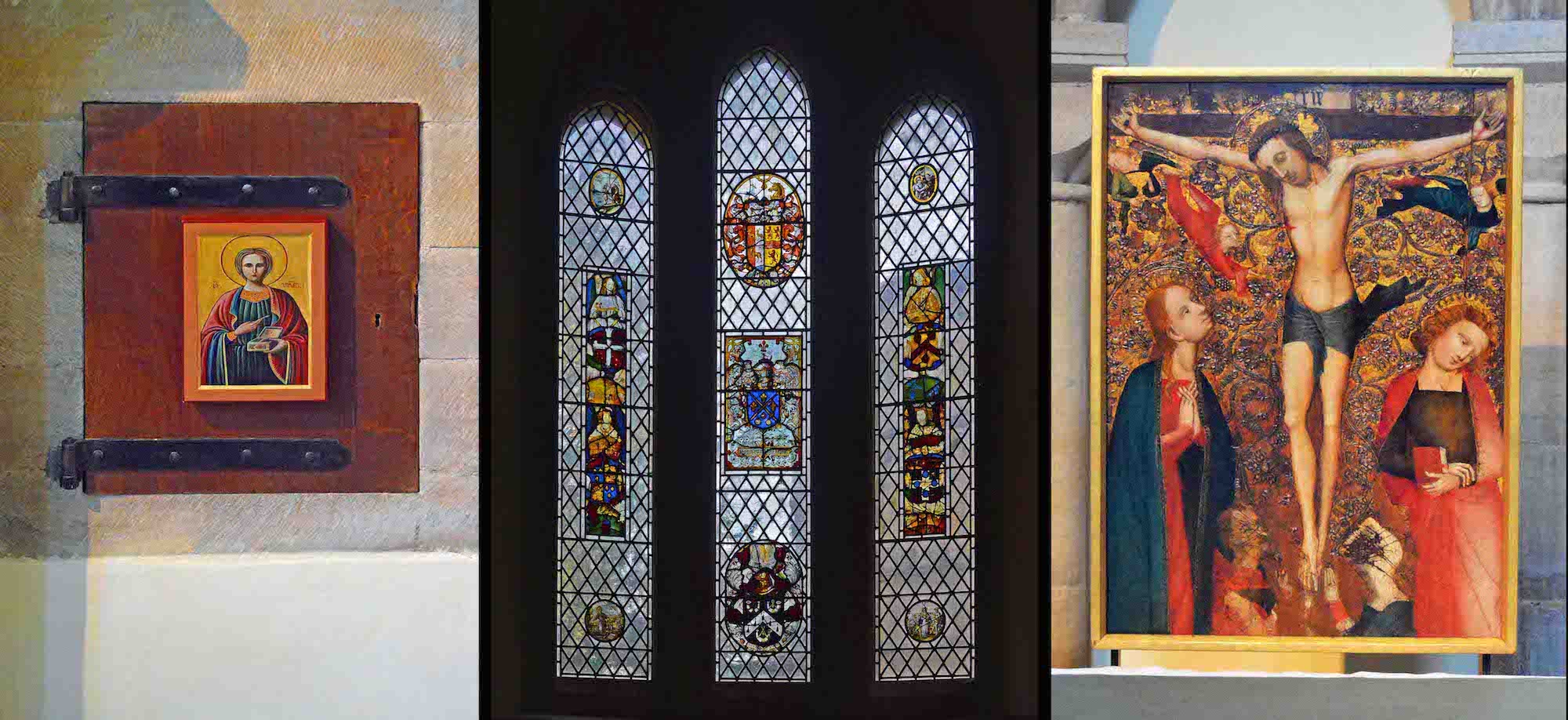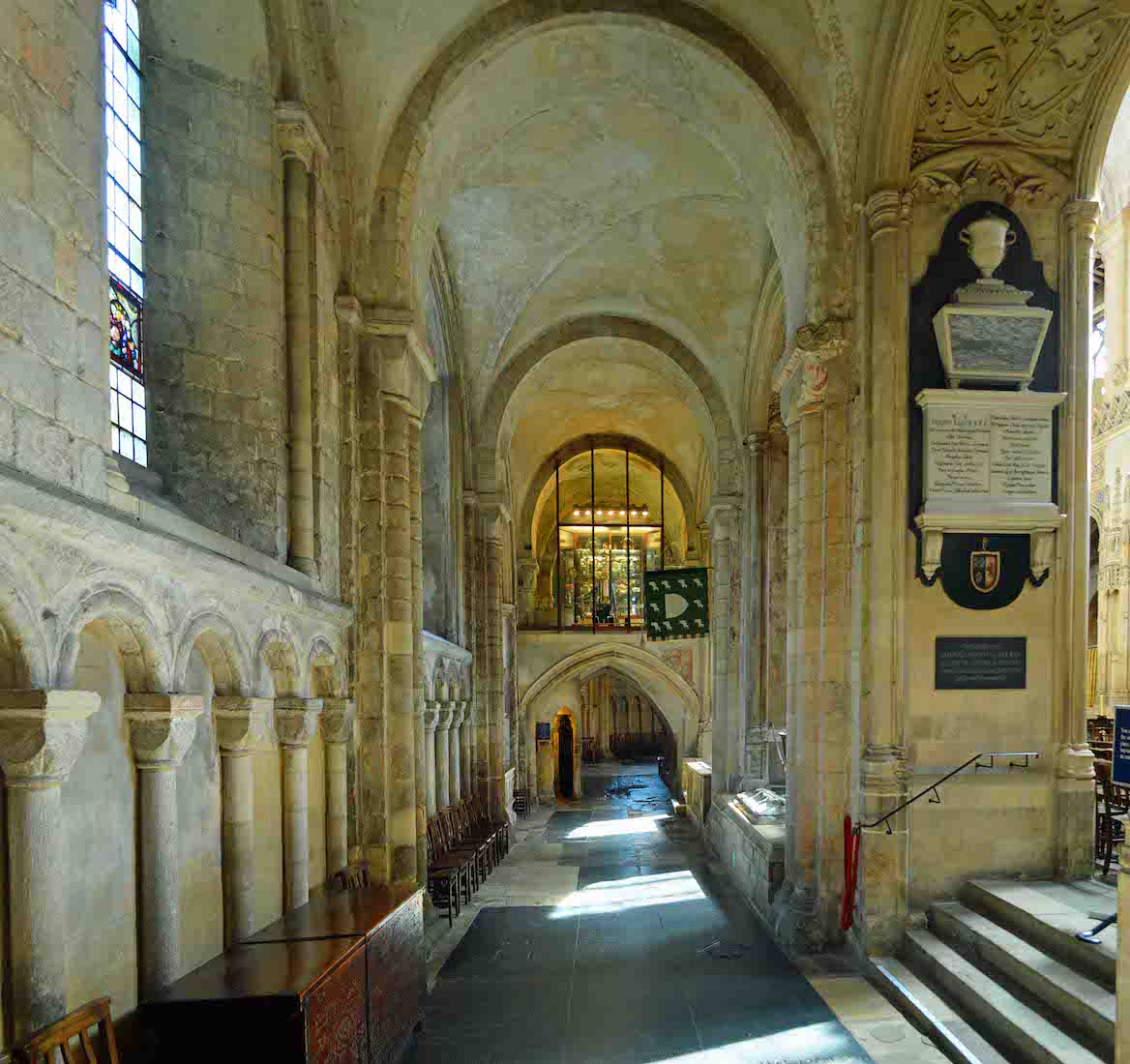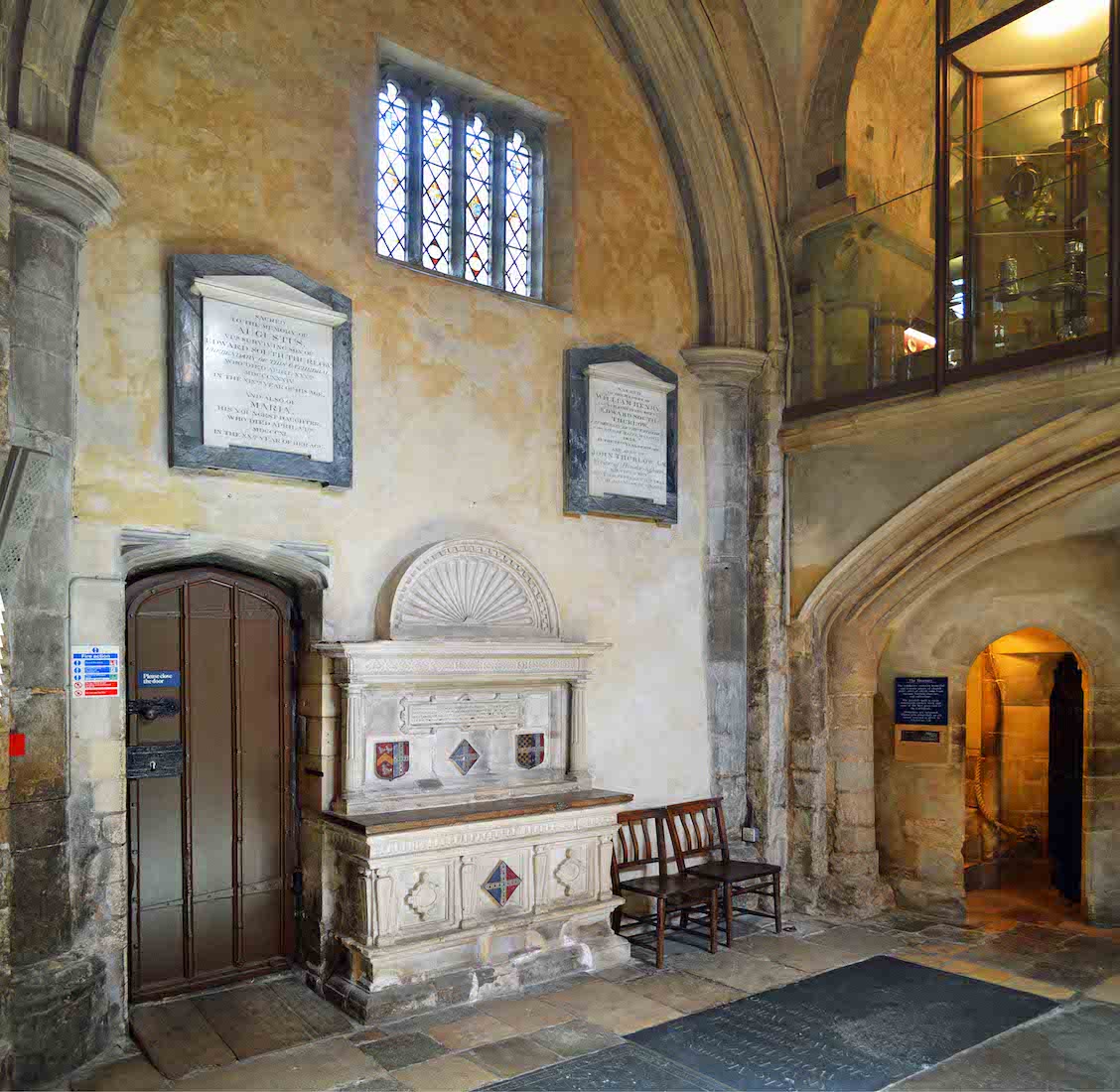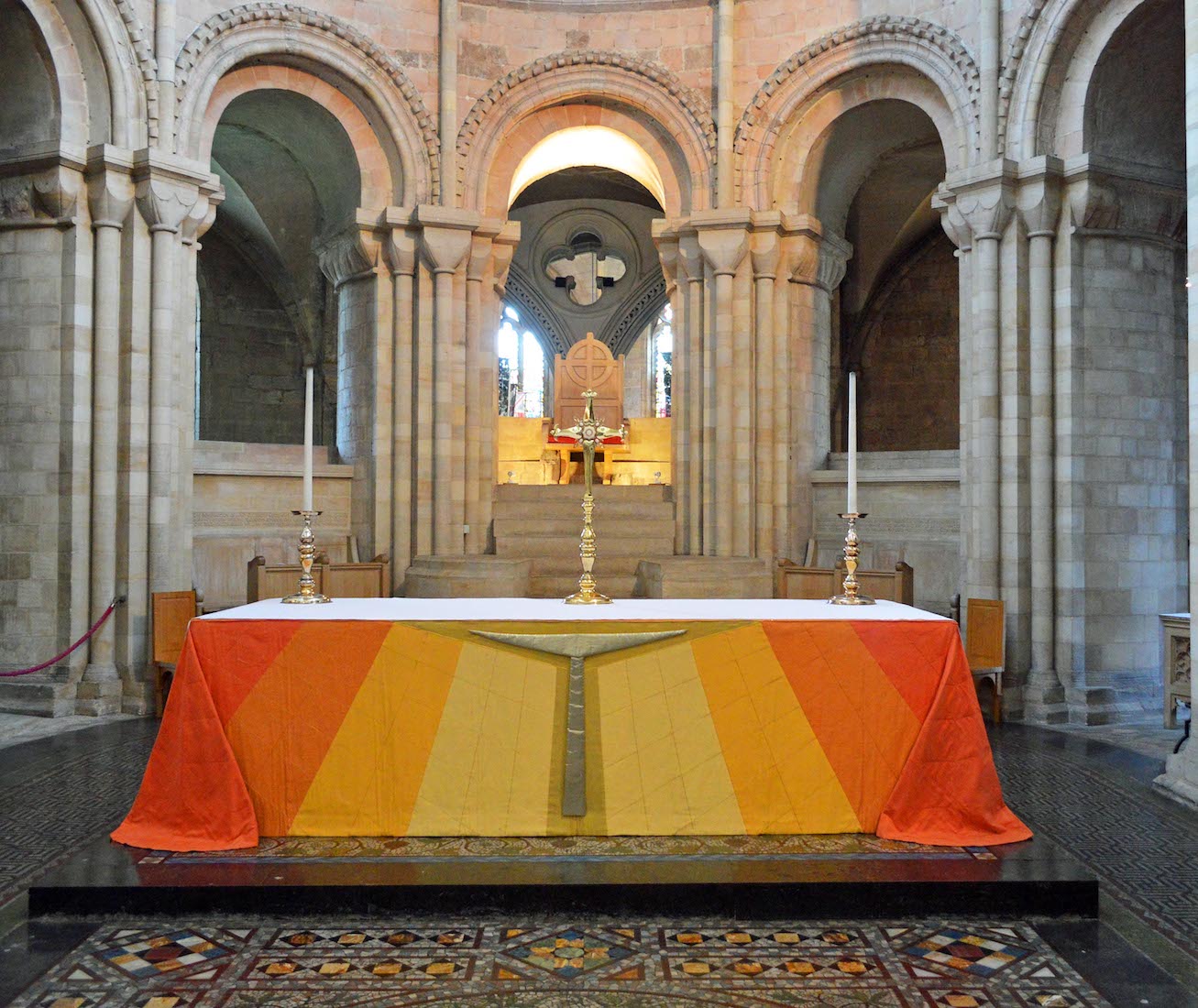
In many cathedrals the high altar is an ornate affair with a highly decorated reredos behind. By contrast, the high altar here is a very simple affair. The bishop's cathedra, or throne of stone, was brought to the new building, and it can be seen today behind the altar. Norwich is one of the few cathedrals in northern Europe to have a cathedra in its original setting behind the altar. PLAN
62. PRESBYTERY VAULTING
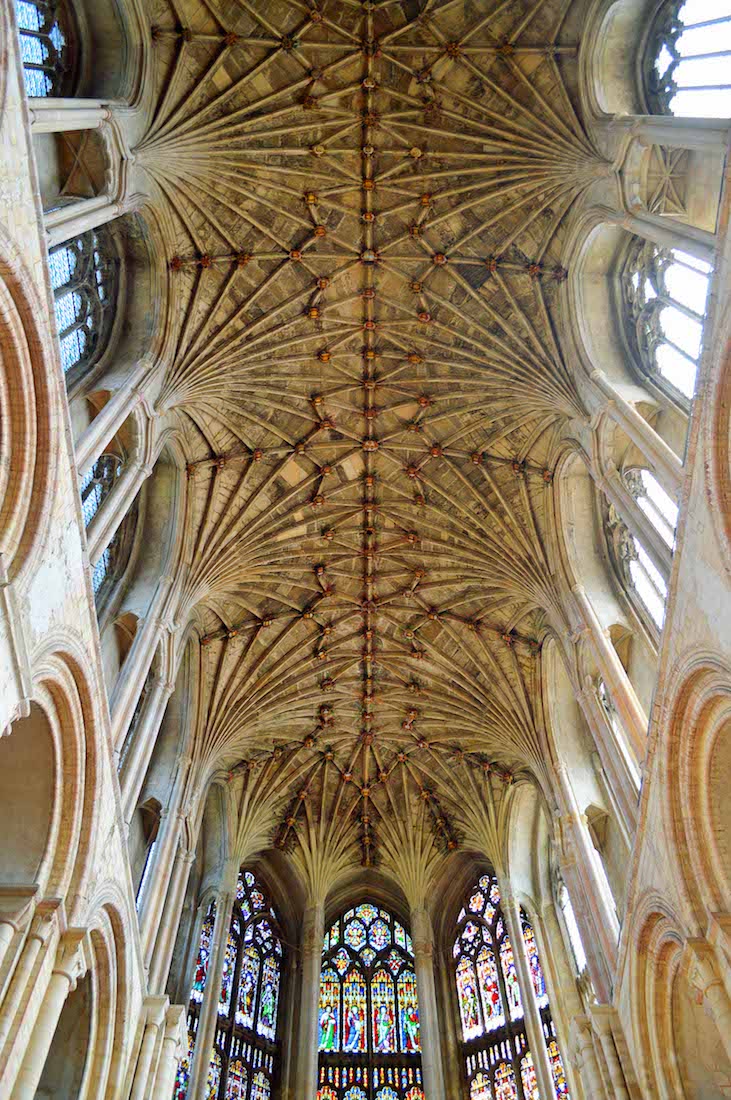
There is more fine fan vaulting above the presbytery. At each join is a colourful boss. These are in fact surprisingly large, but appear small because of the height of the building.
63. TRIFORIUM WINDOW
This 1892 Clayton & Bell window is in a dominant position above the High Altar and Bishop's Throne. It shows Christ the King in all of his glory robed, crowned and with outstretched arms. The words Salvator Mundi are etched beleath his feet. Around him: doves bear scrolls with the seven gifts of the spirits, two seraphs bear scrolls carrying the word ‘Sanctus’ and three kneeling angels carry symbols of the Passion. The window was erected in memory of Edward Berkeley Phipps who died in 1872. [Right photo credit: Mike Dixon]
64. APSE WINDOWS I
High on the Eastern wall of the apse are these three colourful windows. Left window: produced by William Warrington in 1847. Shown left to right: Top row: the apostles Bartholomew, Philip, John and Andrew; Bottom row: St Felix, Bishop Bisi, St Humbertus and Herbert de Losinga. ••• Centre window: designed by Samuel Yarrington in 1843, rearranged by Warrington in 1847. Top row: four of the apostles, namely James the Great, Peter, Paul and James the Less; [Continued ...]
65. APSE WINDOWS II
[Continued] ... Bottom row: the Four Evangelists, with their individual symbols : Matthew (the ‘Divine Man’), Mark (winged lion), Luke (winged ox) and John ( eagle). ••• Right window: produced by William Warrington in 1847. Top row: the apostles Thomas, Matthias, Simon & Thaddeus; Bottom row: Bishop John of Oxford, Bishop Middleton, King Edward I & King Henry VII. [Photo Credits: Mike Davis]
67. NORTH TRANSEPT, WEST WINDOWS I
What we couldn’t see are three stained glass windows framed in the arches to our left. ••• The closest c. 1901 window is dedicated to the memory of Lt Cecil Faulkner Cawston: ‘Lieutenant 13th Hussars who died fighting for his country Feb 1901’. It was made by the firm of William Morris & Co in the style of Burne Jones. The main lights depict three male figures in armour with lances whilst angels can be seen in the tracery. [Continued ... ]
68. NORTH TRANSEPT, WEST WINDOWS II
[Continued ... ] ••• The central c1902 memorial window is dedicated to the 7th (Princess Royal's) Dragoon Guards who fell in the South African War. Designed by Clayton and Bell it depicts an Angel flanked by St George (carrying a white shield with red cross) and St Michael carrying the scales of justice. ••• The right c1903 window is dedicated to William Cadge FRICS made by the firm of Burlison and Grylls. Christ is depicted in a New Testament scene healing the sick above a central scroll that reads: ‘They that are whole need not a physician, but they that are sick’.
69. NORTH TRANSEPT, TOP NORTH WINDOWS
These three panels were originally made by Keith New for the East window of St Stephen's Walbrook in London. The outer windows depict Christ surrounded by the instruments of his Passion. The left window shows Christs’ outstretched arm and Mary kneeling at the cross. In the right window can be seen a ladder, spear and nails whilst on the left is depicted St John at Calvary. The central window depicts St Paul being converted on the road to Damascus. Paul is kneeling beneath palm trees having fallen from his (red) horse. He is being dazzled by Christ who has appeared as a blinding light. [Photo credit: Mike Dixon]
70. NORTH TRANSEPT, MIDDLE NORTH WINDOWS
These three Millenium windows by John Hayward represent the Mystery of the Incarnation. The panels were designed to complement the three Keith New panels above. Here is depicted the Virgin Mary enthroned as the Seat of Wisdom with Jesus, the Wisdom of God Incarnate seated in her lap. [Photo Credit: Mike Dixon]
71. NORTH TRANSEPT DETAIL
Let us look more closely at the North transept wall. There are two more windows, and a (locked) door that might have led us to the Bishop’s garden. In front, a central tomb, two large brass plates, and a white sculpture on either side.
72. NORTH TRANSEPT WINDOWS
Both these windows were designed by Clayton & Bell. The c.1902 window at left is in memory of those of the Norfolk Battalion Regiment who died 1900 - 02. It has a warrior theme and depicts both Joshua and the battle of Gideon. The Regimental badge is displayed in the canopy above Joshua. The c 1902 window at right is in memory of the 1st, 2nd, 3rd & 4th Volunteer Battalion Norfolk Regiment in the South African campaign. The main light depicts Gideon whilst the lower panel shows the Battle of Midian. The Arms of the the city of Norwich are displayed in the canopy.
73. STATUES AND BRASSES
The brasses list the names of members of the Norfolk Regiment who gave their lives in the South African War 1900 – 1902. The statue at left is in memory of Bishop Henry Bathurst who died in 1837 and presided over the Diocese for more than 30 years. The text to the statue of the praying woman at right is obscured, but appears to be in verse. So perhaps she does not have an identity ... .
74. BISHOP PELHAM TOMB
This white recumbent effigy is made of Carrera marble and lies on an alabaster tomb-chest. The carving was made by James Forsyth in 1896. Bishop John Pelham has been described as a ‘low church‘ bishop. He was apparently well liked and produced a volume of hymns. Pelham served as bishop from 1857 to 1893.
75. TO ST ANDREW’S CHAPEL
St Andrew’s Chapel opens up off the East wall of the North transept. We have already seen from the outside that it is semicircular in shape. We go there now ... .
76. ST ANDREW’S CHAPEL ALTAR
The chapel altar is quite simple: a supported slab of marble on which are two candlesticks and an image of the crucifixion.
77. ST ANDREW’S CHAPEL
To the left of the chapel is an aumbry where reserved elements of the Eucharist are kept. The door bears an icon of unknown (to me) derivation. The three lancet windows contain mainly 16th/17th century glass. The 17th century roundel of St John the Evangelist with an Eagle and the 16th Century St Godelva being strangled, are from the Bracon Ash Collection. The window was restored and arranged by G King & Son. The image at right appears on the cover of the book ‘The Sorrowful Way’.
78. THE NORTH AMBULATORY
Leaving the North transept with St Andrew’s Chapel, we make our way up the adjacent North ambulatory. Steps to the right lead up to the crossing, choir and sanctuary. The monument on the column remembers Philip Lloyd who was Dean of the Cathedral 1765–1790. Above the arch at centre we catch a glimpse of the Cathedral treasury. To the left are several stained glass windows.
79. AMBULATORY WINDOWS

The memorial window at left is dedicated to Arnold Kent (1898 – 1976) and was restored and arranged by Dennis King of King & Son 1976. It contains three unrelated panels: a 19th century trefoil of St Michael vanquishing the dragon, a 16th century heraldic fleur de lys, and a mid 16th century French panel depicting the descent of the holy Spirit onto the Virgin Mary and the Apostles at Pentecost. ••• The window at right contains the most important collection of medieval glass in the Cathedral, including examples from the Norwich School of Glass Painting. They were collected by Dennis King of G King & Son in 1963 and given by the Friends of Norwich Cathedral to commemorate Sir Thomas Erpingham (died 1428). [Photo Credit: Mike Dixon]
80. BY THE TREASURY
Continuing along the ambulatory we come to another high window, several memorials, and an interesting spiral staircase. The large memorial by the door remembers Dame ELizabeth Calthorpe, wife of Sir William Calthorpe (1410 – 1494), Knight of the Bath, and Lord of the Manors of Burnham Thorpe, and Ludham, in Norfolk. He is on record as High Sheriff of Norfolk and Suffolk in 1442, 1458, 1464 and 1476.


